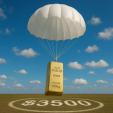Complete Financial Collapse Is Unavoidable
Throughout history, financial markets have risen and fallen in cycles of expansion and collapse. Booms are celebrated, but the busts usually come as surprises—even when the risks are supposedly understood.
Today, multiple warning signs point to the inevitability of a comprehensive collapse of global financial markets. Equities (stocks), bonds, real estate, and commodities will all be affected. This forecast isn’t based on fear or speculation.
It is based on historical precedent and recognition of three specific factors – structural imbalances, unsustainable debt, and systemic overvaluation – any one of which could trigger the collapse.
HISTORICAL PRECEDENT AND MARKET CYCLES
Financial collapses are not anomalies. They are the end result of any or all of the three factors mentioned above. The Dutch Tulip Mania (1637), the South Sea Bubble (1720), the Panic of 1837, the U.S. Banking Panic of 1907, the Great Depression (1929), the Dot-com Bubble (2000), and the Global Financial Crisis/Great Recession (2008) all demonstrate a repeating pattern: artificial expansion driven by leverage, followed by abrupt contraction.
Each cycle has a unique trigger, but the underlying mechanism is the same—excess credit, speculative fervor (fever) and eventual default. In every case, investors believed “this time is different.” Each time, they were proven wrong.
STOCK MARKET OVERVALUATION
Today’s stock markets are historically overvalued by almost every traditional metric:
Price-to-earnings (P/E) ratios for major indexes like the S&P 500 remain well above historical averages.
The Buffett Indicator (market cap-to-GDP) has hovered over 170%, indicating markets are priced far beyond the productive output of the economy.
Corporate buybacks—a major source of stock market growth over the past decade—are financed largely by cheap debt.
Moreover, algorithmic trading, passive investing via ETFs, and highly correlated global markets increase the risk of flash crashes and liquidity spirals. When panic selling begins, the feedback loops will accelerate declines across all asset classes. (see If The Markets Turn Quickly, How Bad Can Things Get?)
BOND MARKET RISK IS ELEVATED
The global bond market—especially sovereign debt—is on a trajectory that cannot be sustained. Consider the following:
As of mid-2025, global debt surpassed $315 trillion, according to the Institute of International Finance.
U.S. federal debt alone exceeds $35 trillion, with annual interest payments now over $1 trillion.
A return to historically normal (higher) interest rates exposes debt holders to massive capital losses and some governments to rising default risk.
The inverse relationship between bond prices and interest rates means that the value of trillions in fixed-income securities will plunge as rates move higher. In the case of credit collapse, the higher rates are because of poor credit quality and defaults.
In the corporate bond market, companies issued record amounts of low-interest debt during the 2010s. Much of this must be refinanced in the coming years at higher rates, which could trigger downgrades, defaults, and bankruptcies.
Bond investors are trapped in a market that can no longer promise safety or positive real returns. (see The Looming Threat Of Credit Collapse And Deflation)
REAL ESTATE
Commercial Real Estate (CRE)
The CRE sector is already collapsing in slow motion:
Office vacancy rates in major U.S. cities (San Francisco, Chicago, New York) have soared past 20%–30%. This is at least, in part, a consequence of the shift to remote work.
Billions in loans tied to these properties are maturing in 2025–2027.
Many buildings are underwater—worth less than the debt attached to them—and face rising interest costs for refinancing.
Banks, especially regional ones, are heavily exposed to CRE. As defaults rise, balance sheet impairments will increase, leading to bank failures or taxpayer bailouts.
Residential Real Estate
While home prices soared from 2020–2022, rising mortgage rates have now priced out many buyers. The affordability crisis means:
Home sales have plummeted.
Inventory is artificially low due to rate-locked sellers.
When forced sales begin (due to job losses or debt stress), prices will adjust sharply downward.
In places like Canada, Australia, and parts of the U.S., price-to-income ratios are in unsustainable territory. A correction is inevitable—and history shows that housing bubbles rarely deflate gently.
COMMODITIES – VOLATILITY, NOT STABILITY
Commodities are traditionally considered inflation hedges or safe havens—but they are not immune to collapse:
Oil and energy markets remain vulnerable to global demand shocks. A deflationary recession will crush consumption and send prices lower, as seen in 2008 and during the COVID-19 collapse.
Agricultural commodities are tied to supply chains, geopolitical tensions, and weather—but also price speculation. Price swings can be large and destabilizing.
Gold and silver, even with recognized monetary roles, are potentially subject to huge declines in price.
INTERCONNECTION AND FRAGILITY
Central banks hold massive amounts of government bonds and mortgage-backed securities on their balance sheets. Pension funds, insurers, and sovereign wealth funds are heavily invested in real estate, equities, and credit markets. Systemically important financial institutions (SIFIs) rely on overnight funding markets, derivatives exposures, and leveraged trades.
A collapse in any one sector—stocks, bonds, real estate—will spawn reverberations that spread quickly. No part of the financial infrastructure operates in isolation anymore.
Central banks—especially the Federal Reserve—are caught between the proverbial rock and a hard place. If they raise rates to tame inflation, they destroy asset prices and increase default risk. If they lower rates or restart quantitative easing (QE), the increased inflation debases the currency.
CONCLUSION
Confidence is the last line of defense in any monetary system. Trust in the central bank is falling amid accusations of policy errors and inflation denial. Dishonesty and deceit are rampant at all levels of government and in all departments and agencies; and, financial institutions are plagued by scandals and corruption.
As seen historically—from Weimar Germany to Argentina to 1970s America, as well as currently — the erosion of confidence leads to the flight of capital, currency devaluation, and civil unrest.
Geopolitical instability (e.g., war in Eastern Europe, Middle East conflict, U.S.-China tensions) exacerbates the financial stress and hastens the the eventual collapse.
CONCLUSION
A complete collapse of financial markets is not only likely—it is inevitable under current conditions. It will be the cumulative result of decades of unsound money practices and disregard of fundamental economics.
Today’s modern financial and economic system, based on fiat currency and leverage (credit), is ripe for failure. (also see No Winners When The Inflation Balloon Pops)
Kelsey Williams is the author of two books: INFLATION, WHAT IT IS, WHAT IT ISN’T, AND WHO’S RESPONSIBLE FOR IT and ALL HAIL THE FED
*********
















